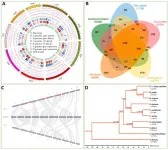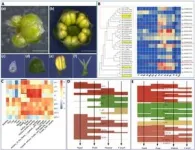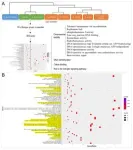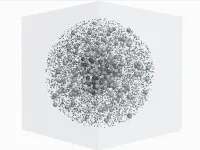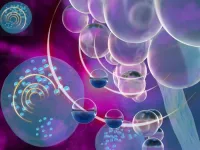Recently, a research paper titled "Chromosome-scale genome sequence of Suaeda glauca sheds light on salt stress tolerance in halophytes", completed by Professor Qin Yuan's team from the Center for Genomics, Haixia Institute of Science and Technology (Future Technology College) at Fujian Agriculture and Forestry University, has been published in the top-ranked journal "Horticulture Research" in the field of horticultural science.
Soil salinity is a growing concern for global crop production and the sustainable development of humanity. Therefore, it is crucial to comprehend salt tolerance mechanisms and identify salt-tolerant genes to enhance crop tolerance to salt stress. S. glauca, a halophyte species well-adapted to the seawater environment, possesses a unique ability to absorb and retain high salt concentrations within its cells, particularly in its leaves, suggesting the presence of a distinct mechanism for salt tolerance.
In this study, the authors performed de novo sequencing of the S. glauca genome. The genome has a size of 1.02 Gb (consisting of two sets of haplotypes) and contains 54,761 annotated genes, including alleles and repeats. Comparative genomic analysis revealed a strong synteny between the genomes of S. glauca and B. vulgaris. Of the S. glauca genome, 70.56% comprises repeat sequences, with Retroelements being the most abundant (Fig. 1).
Leveraging the allele-aware assembly of the S. glauca genome, we investigated genome-wide allele-specific expression in the analyzed samples. The results indicated that the diversity in promoter sequences might contribute to consistent allele-specific expression (refer to full text for details). The typical angiosperm flower consists of four whorls: sepal, petal, stamen, and carpel, although deviations from this arrangement can occur in some species. In S. glauca, only three whorls were observed, with the first whorls significantly degraded and the second whorls exhibiting sepal-like characteristics. The third and fourth whorls show the normal phenotype (Fig 2A). To confirm the sepal-like identity of the second whorl of the S. glauca flower, we analyzed the expression of genes involved in photosynthesis and chlorophyll synthesis-related pathways. The clustered heat maps showed that the expression patterns of the genes examined in the second whorls were similar to those of the sepals. Moreover, a systematic analysis of the ABCE gene family shed light on the formation of S. glauca's flower morphology, suggesting that the dysfunction of A-class genes is responsible for the absence of petals in S. glauca (Fig. 2).
In order to gain an in-depth understanding of the salt tolerance mechanisms in Suaeda genus plants from a genomic perspective, we conducted a comparative genome analysis between Suaeda species, including Suaeda aralocaspica (a salt-tolerant plant within the Amaranthaceae family) and other non-salt-tolerant species from the same family. The results revealed a significant expansion of gene families in these two salt-tolerant Suaeda species, encompassing a total of 1840 genes (Fig. 3A). Enrichment analysis of these genes unveiled a notable enrichment of Gene Ontology (GO) terms related to DNA repair, chromosome stability, DNA demethylation, cation binding, and red/far-red light signaling pathways within the shared expanded gene families of Suaeda species (Fig. 3B). In comparison to non-halophytic species in the Amaranthaceae family, the expanded genes in Suaeda species are predominantly enriched in the "DNA/chromatin stability maintenance" function. This suggests that the role of "DNA/chromatin stability maintenance" may play a crucial role in the salt tolerance of Suaeda plants.
To further validate the aforementioned observations, we conducted a temporal RNA-seq analysis on salt-treated Suaeda plants. Cluster analysis of differentially expressed genes at various time points following salt treatment was shown in Fig. 4A, B. Notably, the transition-up genes were identified as a stable response mechanism for S. glauca to cope with salt stress. Interestingly, the transition upregulated genes in leaves were mainly associated with DNA repair and chromosome stability, along with GO enrichment related to lipid biosynthetic process and isoprenoid metabolic process. These results are consistent with the previous analysis of the S. glauca gene family expansion (Fig. 4C). Additionally, genome-wide analysis of transcription factors indicated a significant expansion of the FAR1 gene family (refer to full text for details). However, further investigation is needed to determine the exact role of the FAR1 gene family in salt tolerance in S. glauca.
In this study, we de novo assembled the haploid genome of S. glauca at the chromosomal level. The genome sequence is of high quality, and the annotation is extensive, establishing it as a reference genome for the halophyte S. glauca. Additionally, we elucidated a novel salt tolerance mechanism involving "DNA/chromatin stability maintenance" in halophytic plants. To our knowledge, this mechanism of salt tolerance is a recent discovery within halophytic plants, potentially offering new insights and avenues for enhancing crop salt tolerance.
###
References
Authors
Yan Cheng, Jin Sun, Mengwei Jiang, Ziqiang Luo, Yu Wang, Yanhui Liu, Weiming Li, Bing Hu, Chunxing Dong, Kangzhuo Ye, Zixian Li, Fang Deng, Lulu Wang, Ling Cao, Shijiang Cao, Chenglang Pan, Ping Zheng, Sheng Wang, Mohammad Aslam, Hong Wang, Yuan Qin
Affiliations
1State Key Laboratory of Ecological Pest Control for Fujian and Taiwan Crops, College of Plant Protection, Fujian Provincial Key Laboratory of Haixia Applied Plant Systems Biology, Center for Genomics and Biotechnology, College of Life Science, Fujian Agriculture and Forestry University, Fuzhou 350002, China;
2Pingtan Institute of Science and Technology, Fujian Agriculture and Forestry University, Fuzhou 350400, China;
3Department of Biochemistry, Microbiology and Immunology, University of Saskatchewan, Saskatoon, SK S7N 5E5, Canada;
4College of Agriculture, Fujian Agriculture and Forestry University, Fuzhou 350002, China;
5College of Forestry, Fujian Agriculture and Forestry University, Fuzhou 350002, China;
6Fujian Key Laboratory on Conservation and Sustainable Utilization of Marine Biodiversity, Fuzhou Institute of Oceanography, Minjiang University, Fuzhou, 350108, China
About Yuan Qin
Dr. Qin Yuan is a distinguished academic figure with a Ph.D. in Developmental Biology. She currently holds the positions of Professor, Doctoral Supervisor, and Dean of the School of Life Sciences at Fujian Agriculture and Forestry University.
Her academic journey began with a Bachelor's degree in Pharmacy from Wuhan University in 2001, followed by a Ph.D. in Developmental Biology from the same institution in 2006. Between 2006 and 2009, she conducted postdoctoral research in the Department of Plant Sciences at the University of Arizona in the United States. Subsequently, from 2009 to 2014, she served as an Associate Researcher at the Institute of Plant Physiology and Ecology within the Shanghai Institutes for Biological Sciences, Chinese Academy of Sciences. Since 2014, she has been a dedicated professor at Fujian Agriculture and Forestry University.
Dr. Qin's exceptional contributions and expertise have garnered her numerous recognitions. She is esteemed as a Class B high-level talent in Fujian Province and was awarded the Fujian Provincial Natural Science Award (Second Prize) in 2020 as the lead author. She is a recipient of the prestigious "National Excellent Young Scientist Fund" and the esteemed "Newton Advanced Fellowship" as part of the Sino-British Talent Program. Furthermore, she is affiliated with the "Hundred Talents Program" and holds key positions in higher education leadership in Fujian Province. Her contributions extend beyond academia; she is a specially appointed "Minjiang Scholar" professor and a distinguished expert in the Guangxi Zhuang Autonomous Region.
Dr. Qin's accomplishments extend to various awards, including the Fujian Youth Science and Technology Award, the Fujian Yunsheng Youth Science and Technology Award, and the Fujian Youth May Fourth Medal. She has also been recognized with the "Upward and Virtuous Educator Engineering Fund" teaching award. In addition, she led a team to secure the Bronze Prize in the National Postdoctoral Innovation and Entrepreneurship Competition.
Her impactful research portfolio encompasses more than ten national and provincial projects, encompassing domains such as the "National Natural Science International Cooperation Project," "National Natural Science Foundation Key Project of Cross-Strait Joint Fund," "National Natural Science Excellent Young Scientist Fund Project," and "National Natural Science Foundation General Project." Her research centers around plant reproductive development, culminating in three authored books/chapters and five invention patents. Dr. Qin's scholarship is reflected in over 80 relevant publications, including more than 60 SCI-indexed papers in esteemed journals such as PNAS, Current Biology, and Plant Cell, among others.
Dr. Qin's commitment extends to editorial roles, including Deputy Editor-in-Chief of the "Journal of Tropical Biology," and as an editorial board member for journals like "Communications Biology," "Tropical Plant Biology," and "Subtropical Plant Science." She also actively contributes to academic committees, such as the Cell Biology Special Committee of the Botanical Society of China. Her role as a second-round reviewer for the National Natural Science Foundation and an evaluator for the "Young Thousand Talents Program" underscores her expertise and influence.
Her dedication to education is evident through her supervision of graduate students, many of whom have been awarded three Provincial Outstanding Doctoral Dissertation Awards and one Provincial Outstanding Master's Dissertation Award.
For inquiries or contact, Dr. Qin Yuan can be reached at yuanqin001@foxmail.com.
END
